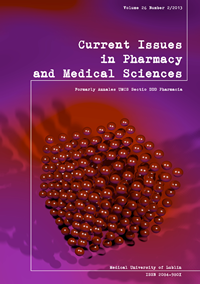A comparison of the selectivity of nano-HPTLC systems used for determination of patulin in fruit juices from the internet stores
DOI:
https://doi.org/10.12923/j.2084-980X/26.2/a.08Keywords:
HPTLC, normal-phase chromatography, patulin, apple juiceAbstract
The new nano-HPTLC method was proposed for improved separation of patulin from the admixture of the three naturally occurring natural components of fruit juices, which in last years could be often obtained from the internet functional food stores and pharmacies. Separation of patulin (P) from quercetin (Q), ascorbic acid (A) and 5-hydroxymethylfurfural (H) was performed using three different ready-for-use plates NanoAdamant (NA), Nano-SIL-20 (NSIL) and Nano-Durasil-20 (ND) covered with the non-modified silica gel layer. After development on the 8.0 cm distance, the nano-HPTLC plates were sprayed with 0.5% aqueous solution of the 3- methyl-benzothiazolinone hydrazone hydrochloride hydrate (MBTH). Most satisfactory separation of patulin from the each mentioned compounds was obtained using the Nano-SIL-20 plates and toluene-ethyl acetate-98% formic acid (25:20:5, v/v/v) as the mobile phase. In this best nano-HPLTC method the limit of detection of patulin was near 2.5 times lower (4 ng/spot) in comparison to other used here chromatographic systems. Thus, this optimized nano-HPTLC mode could be used for analysis of the solid-phase extracts of patulin from the fresh apples, clarified apple juices and other fruit products.
References
1. Bazylak G., Brózik H., Sabanty W.: Combined SPE and HPTLC as a screening assay of urinary cotinine from male adolescents exposed to environmental tabacco smoke. Pol. J. Environ. Studies, 9(2), 113, 2000.
2. Elhariry H., Bahobial A.A., Gherbawy Y.: Genotypic identification of Penicillium expansum and the role of processing on patulin presence in juice. Food Chem. Toxicol., 49(4), 941, 2011.
3. Erdogan A., Gurses M, Sert S.: Isolation of moulds capable of producing mycotoxins from blue mouldy Tulum cheeses produced in Turkey. Int. J. Food Microbiol., 85(1), 83, 2003.
4. Halkina T., Sherma J.: Comparative evaluation of the performance of silica gel TLC plates and irregular and spherical-particle HPTLC plates. Acta Chromatographica, 17(3), 261, 2006.
5. Kasperek R., Czarnecki W., Januszek M.: Separation of hydrocortisone acetate and phenyl salicylate from the pharmaceutical solid dosage forms by the thin-layer chromatography. Ann. UMCS Sect. DDD, 20(1), 1, 2007.
6. Martins M.L., Gimeno A., Martins H.M. et al.: Co-occurance of patulin and citrinin in Portuguese apples with rotten spots. Food Addit..Contam., 19(6), 568, 2002.
7. Nagaraju P.M., Sanganalmath P.U., Kemparaju K., et al.: Evaluation of separation parameters for selected organophosphorus fungicides of forensic importance by RP-HPTLC. Acta Chromatographica, 24(2), 253, 2012.
8. Scott P.M., Kennedy B.P.C.: Improved method for the Thin Layer Chromatographic determination of patulin in apple juice. J. AOAC., 56(4), 813, 1973.
9. Stępień M., Sokół-Leszczyńska B., Łuczak M.: Mykotoksyny, produkty spożywcze a zdrowie człowieka. Post. Mikrobiol., 46(2), 167, 2007.
10. Sullivan C., Sherma J.: Comparative evaluation of TLC and HPTLC plates containing standard and enchanced UV indicators for efficiency, resolution, detection and densitometric quantification using fluorescence quenching. J. Liq. Chromatogr. Rel. Technol., 27(13), 1993, 2004.
11. Śliwińska A., Przybylska A., Bazylak G. In: Chromatografia w praktyce. A. Voelkel, W. Wasiak (Red.), Wyd. Polit. Poznańskiej, Poznań 2001, Ch. 1.5, p. 53-64.
12. Tolivia J., Navarro A., del Valle E., et al.: Application of Photoshop and ScionImage analysis to quantification of signals in histochemistry, immunocytochemistry and hybridocytochemistry. Anal. Quant. Cytol. Histol., 28(1), 43, 2006.
13. Web homepage of the Macherey Nagel GmbH (Duren, Germany): http://www.mn-net.com/tabid/5569/default.aspx, Accessed: 15 Feb. 2013.
14. Welke J.E., Hoeltz M., Dottorii H.A., et al.: Patulin accumulation in apple during storage by Penicillium expansum and Penicillium griseofulvum strains. Braz. J. Microbiol., 42(1), 172, 2011.
Downloads
Published
Issue
Section
License
Copyright (c) 2013 Authors

This work is licensed under a Creative Commons Attribution-NonCommercial-NoDerivatives 3.0 Unported License.


